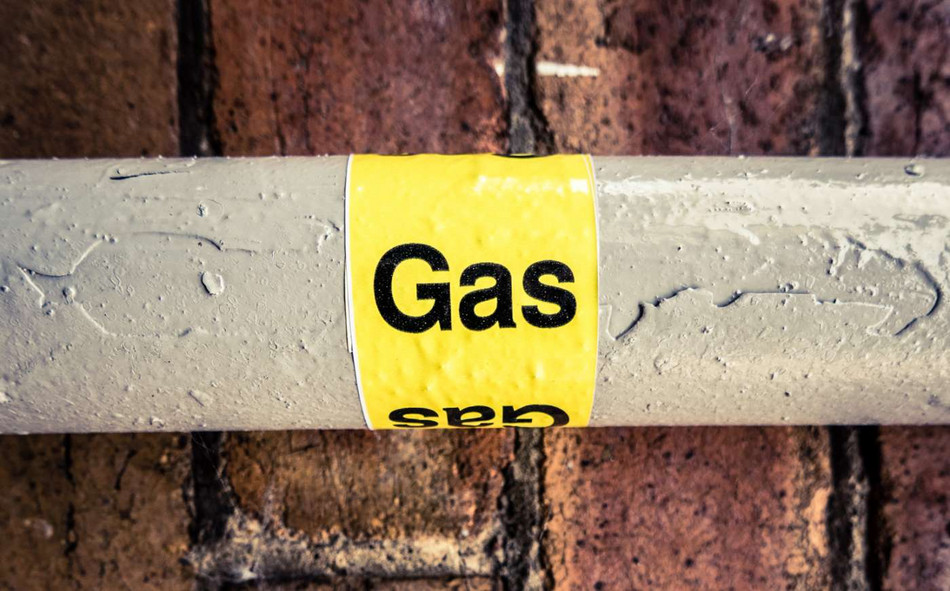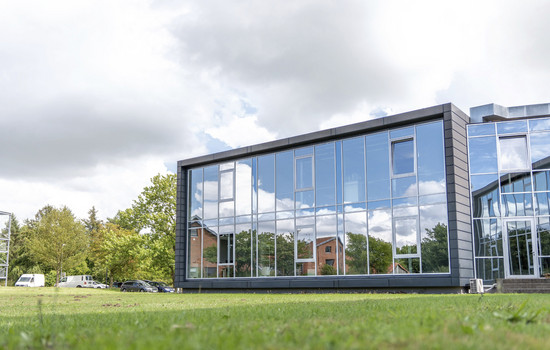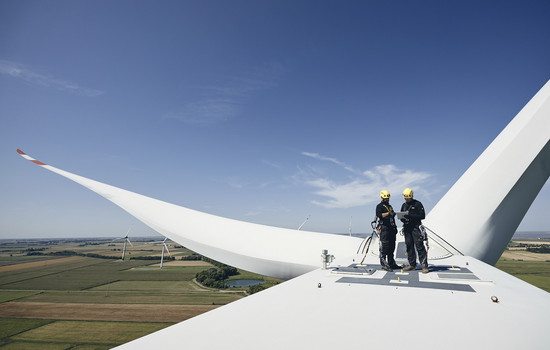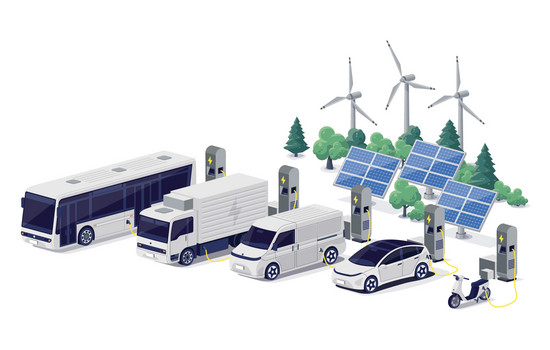Galvanised

THE GP JOULE-MAGAZINE NR. 13 / NOVEMBER 2022
Germany’s electricity supply has been getting greener for the last 20 years. But governments, the heating sector and industry alike have slept through the restructuring of the heating supply. A rude awakening is now here.
No one can say there haven’t been any wake-up calls. Environmental organisations, renewable energy associations and other experts have been sounding alarm bells for years. Germany’s heating sector is like a sleeping giant though. Heating, cooling and hot water together accounted for 58 per cent of enduser energy consumption in Germany in 2021. Less than 16 per cent of this came from renewable sources.
Every now and then, the sleeping giant got a bit of a poke. For example, with subsidies for the installation of solar panels via the market incentive programme or the federal subsidy for efficient buildings. Or in the form of the Renewable Energies Heat Act (EEWärmeG), which has required a minimum proportion of green heat in new houses since 2009. The requirements were only modest though, and the exceptions too many to mention. At the same time, fossil fuel companies and heating technology manufacturers carried on singing their soothing lullabies and the giant snored on. Even then, it was clear from the climate science point of view that a move away from gas had to come. Denmark’s example shows it would have been possible. Oil and gas heating systems have progressively been banned there from 2013 onwards. Until the summer of 2022, on the other hand, our federal government were continuing to pay subsidies for supposedly modern natural gas condensing technology – a technology from the previous millennium. Those who bought a new natural gas heating system more or less rested easy in the knowledge that they had chosen a clean and safe energy source. The international gas market also reinforced this belief.
The price increases of the early 2000s reversed when the USA introduced large quantities of natural gas from fracking projects to the market in the 2010s. Natural gas forever. They weren’t concerned in German boiler rooms about melting glaciers and increasing droughts elsewhere.
Only recently have the pokes become more persistent, the giant’s sleep more restless. Since the CO2 tax has been in place, anyone buying a fossil-fuel heating system knows that they will have to reckon with significant cost increases during its lifetime. Prices for fossil energy sources had already increased noticeably in 2021.
But the big bang only came on 24 February 2022, when Russian soldiers invaded Ukraine. Now the giant is wide awake. Every day, the news wail like sirens in his ears: there’s hardly any more gas coming from Russia! Rivers are running dry and our power plants have to be throttled down! The harvest is withering in the fields! Food prices are rising!
Climate and energy crisis are colliding – and not just in some far-flung corner of the world, but right here, in the heart of Europe, in the middle of Germany.
Germany’s electricity supply is also far from being completely green. However, unlike heat, about half of the electricity comes from renewable sources, and by 2030 this figure should have grown to around 80 per cent. Wind and solar power are now among the cheapest energy sources in Germany. They are also the only ones that can be generated almost indefinitely and locally, so they need to rapidly become the basis of our energy supply.
The limitations of the all-electric world
New heating systems must use 65 per cent renewable energy from 2024 onwards. The easiest way to do this is using a heat pump, which converts one kilowatt hour of green electricity into about three kilowatt hours of heat. One in two newly-built houses was already fitted with a heat pump in 2020. However, they do have their limits, especially in densely built-up cities. Where houses are densely packed together and there is already hardly enough space to put the bins, it is difficult to find a space for the outdoor units of air heat pumps or an area for ground heat exchangers. The power lines run hot when everyone wants to heat at the same time. And the heat pump’s efficiency falls away where the houses are not insulated and the radiators need high temperatures. “Electrification of heat is a good thing in many places. But it has its limits. An all-electric world, as some scenarios would envisage, is not the solution. And even insulation is not the panacea. What we need is an intelligent mix,” says GP JOULE Co-Founder and Chief Executive Officer Ove Petersen. Electricity, heat and gas all have specific strengths and weaknesses as energy forms that can complement each other. “In most urban areas and in some rural communities as well, heating networks are the fastest, most effective and most resource-efficient way to achieve the heating transition,” says Petersen.
Heating networks connect sectors
A major advantage of heating networks is that they can coll ect heat from a wide variety of sources at different locations. They then take it to where it is needed. Th is can be waste heat from industry, for example, which many companies still emit into the air or into bodies of water. Data centres also convert their immense energy consumption almost entirely into heat. Gett ing rid of this heat devours additional energy for cooling.
On top of this come the new sector coupling technologies. The prioritisation of the heat sources can change, depending on the current level of green electricity generation and consumption. Heat is also generated where green hydrogen is produced by electrolysis with green electricity. And where this hydrogen is turned back into electricity in a fuel cell, again you get heat. Conversely, electric heat pumps can feed energy into the grid when there is plenty of electricity available.
One advantage of such large heat pumps is that they do not rely on ambient air as a heat source, but can be install ed where large quantities of low-temperature heat is available – in sewage systems, for example, or at wastewater treatment plants. And when energy needs to be quickly drawn from the power grid in strong winds and used sensibly, electric heating lances convert the electricity directly into district heating. Another benefit: central heat pumps are “electricity- controlled”. Th is means that the heat pump is switched on when the electricity is cheap and the heat is temporarily stored. They therefore have a large heat storage capacity. Most heat pumps in single-family houses, on the other hand, are heat-controlled. They do not have a large storage capacity and their capacity, for the most part, is not designed to adapt to the electricity market. That’s why they have to run even when electricity is expensive. A small number of central heat generators also take up fewer resources, energy and skilled workers – all of which are scarce factors for the energy transition – than a large number of small individual generators.
Heating networks have only one drawback: they are costly to construct. Kilometres of pipes have to be laid and roads dug up. But once constructed, they open up a multitude of possibilities.
Denmark leads the way
Denmark shows that such a conversion can be achieved in a short time. There, in contrast to Germany, the oil crises in the 1970s and 1980s were seized as an opportunity to develop a long-term strategy for an independent and sustainable energy supply. The expansion of renewable energies formed one pillar of this, efficiency and system integration the other two. In practice, this led not only to a massive expansion of wind energy, but also of district heating networks. In the 1980s, Denmark rushed to lay new pipelines, and heating networks are now the dominant type of interior heating in Denmark. The heat in the grids comes to a large extent from decentralised CHP plants, operated with natural gas, biomass and waste. Flexibility was an essential aspect from the very beginning. CHP plants in Germany are oft en large coalfired piles. They work around the clock, even when no one wants the electricity at that time. The plants in Denmark, on the other hand, were designed from the outset to adapt their electricity generation to demand. The heat is temporarily stored in large tanks.
This set-up lets the Danish heating networks respond well to changing conditions. As the proportion of wind power in Denmark increased, the combined heat and power plants throttled back their operation. The country set climate targets – huge fields of solar panels generate heat and feed it into the pipes. The proportion of wind power continued to rise and the first large heat pumps appeared on the market, converting wind power into heat. “The heating networks were more expensive to build. But the Danes put their faith in security of supply and now have precisely that. The heating networks have given them unheard of independence from a single heat source, which is priceless today,” Petersen sums up. “That should be much more of a focus for us as well.”
So while the Danes can respond centrally, our federal government has to constantly try and persuade millions of private individuals and businesses to switch to more climate-friendly energy sources using a patchwork of subsidies, persuasion and regulations. And with the many decentralised gas heating systems not being convertible in a mere few months and fuel costs rising, millions of people are now wondering how they are going to pay their heating bills this winter.
Storing heat is inexpensive
A secure energy supply needs storage facilities – and in this respect too, heating networks come into their own. Scarce and ecologically dubious materials such as lithium or rare minerals are not needed for heat storage. Water as a storage medium costs next to nothing, is non-toxic and available almost everywhere in Central Europe. One cubic metre of water heated from 30 to 60°C absorbs just under 35 kilowatt hours of thermal energy.
The Danish networks are role models here as well. They store the heat in huge volumes of water in the ground. The largest of these facilities in the municipality of Vojens holds 210,000 m3 of water. It needs some modification to transpose the concept to cities, because space is usually more of a problem there. But there are alternatives. Ice storage facilities use the large amount of energy that water absorbs when it thaws and releases again when it freezes. Heat pumps bring the energy to a usable temperature level. They are already being used in a range of projects. Aquifer reservoirs, on the other hand, exploit underground natural water reservoirs. This technique is to be trialled in Hamburg. And an Austrian research project is working on huge water reservoirs on whose surface parks or ponds can be built. Large amounts of energy can be stored in this way even when space is at a premium.
The storage facilities not only make energy constantly available, but also cheaper. Since heat pumps, solar coll ectors, etc. provide heat in addition to the actual generators when consumption is high, they can be smaller. At the same 8 time, they ensure that available heat can always be absorbed. That way nothing gets lost.
Act quickly and reduce emissions
Heating networks being such an essential component of the energy transition, they have been part of GP JOULE’s strategy from the very beginning. Around 70 employees now deal with the planning, financing, construction and operation of the generation plants and networks. This is often done in an operating company where the municipality also has a stake alongside GP JOULE. There is great interest – among new customers as well as old. “Once a start is made, requests for expansion usually flow in quickly,” says Petersen.
So it is all the better that wind and solar energy can be relied on even in the energy crisis. “We have plenty of space,” says Petersen. Now things have to move quickly. If this is to succeed, the political will needs to be there to implement projects and support in building local value chains. “The carbon footprint today of wind and solar energy is already small. So far, however, we are heavily dependent on China. A strong European solar and wind industry can help us become truly climate neutral and independent,” says Petersen. But there’s not much time left for that after the years of hibernation.
![[Bitte in "English" übersetzen:] [Bitte in "English" übersetzen:]](/fileadmin/_processed_/8/9/csm_gp_jamesblog_14_7a870ae12b.jpg)




![[Bitte in "English" übersetzen:] [Bitte in "English" übersetzen:]](/fileadmin/_processed_/a/6/csm_GP_29.01.24_ZweiVonUns-Olaf_header_2d7a81f45d.jpg)